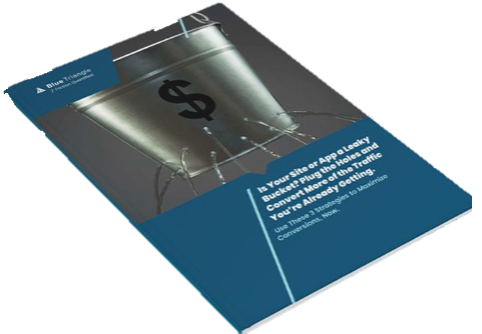With the surge of eCommerce and mobile apps, understanding the customer journey across all digital touchpoints is crucial for businesses.
In fact, more than 65% of US smartphone users will use retail apps this year, putting the category behind only navigation and weather apps.
But the rise of mobile app adoption is a trend across many industries, including mobile banking, travel booking, ride-sharing, and food and grocery delivery.
For consumers, mobile apps can be more convenient than other channels for shopping and transacting.
- Your customers now expect a fast, reliable app experience with an app that’s available 24/7/365.
- They expect it to take just a few clicks to transact because your app remembers their preferences, payment details and past purchases so that repeat purchases are easy.
- Your customers want same-day delivery, and they expect your app to be as fast and simple as your desktop website so they can transact from anywhere.
And for businesses, mobile apps pose a major opportunity for brands to connect with consumers, build customer trust and loyalty, and unlock more conversions and revenue.
5 Ways a Frictionless Mobile App Experience Can Financially Benefit a Business
A frictionless mobile app experience can financially benefit businesses in several ways:
1. Increased Sales and Conversions.
A smooth and intuitive mobile app experience reduces barriers to purchase, leading to higher conversion rates. Customers are more likely to make purchases When they can easily browse products, add items to their cart, and complete transactions without encountering friction or technical issues. This directly translates into higher revenue for the business.
2. Higher Customer Lifetime Value.
A frictionless mobile app experience enhances customer satisfaction and loyalty, encouraging repeat purchases and long-term engagement with the brand. Satisfied customers are more likely to return to the app for future transactions, increasing their lifetime value to the business.
3. Reduced Cart Abandonment Rates.
One common source of lost revenue for online businesses is cart abandonment, where customers add items to their shopping cart but fail to complete the purchase. A frictionless mobile app experience can help reduce cart abandonment rates by streamlining the checkout process, offering multiple payment options, and providing clear navigation cues. Businesses can recover potentially lost revenue and improve overall conversion metrics by minimizing friction at every stage of the purchasing journey.
4. Foster Customer Trust and Loyalty.
A well-designed mobile app ensures a consistent experience across devices and touchpoints. When the app is easy to navigate and use, customers appreciate the convenience it offers. They can quickly find what they're looking for, make purchases seamlessly, and access information without friction. A smooth and secure mobile app experience also contributes to the perception of the brand as trustworthy
5. Data Storytelling and Personalization Opportunities.
Mobile apps generate valuable data about customer behavior, preferences, and interactions. Businesses can leverage this data to drive targeted marketing campaigns, personalize experiences, and identify opportunities for upselling or cross-selling. By harnessing the power of data analytics, businesses can unlock new revenue streams and maximize the financial return on their mobile app investment.
Overall, a frictionless mobile app experience can significantly impact a business's financial performance, drive conversions and revenue, and foster customer trust and loyalty, contributing to long-term success.
Mobile App Friction Can Cause Users to Abandon Before They Convert
But what's preventing businesses from reaping the financial benefits of frictionless mobile app experiences?
Well, friction.
To be more precise, unresolved friction in your customers' journeys that observability, session replay, and marketing analytics tools alone cannot uncover or connect back to conversion or revenue impact.
Users can experience various types of friction when using a mobile app, hindering their overall experience and leading to frustration or dissatisfaction.
Here are some common sources of mobile app friction:
1. Complex User Interface.
A cluttered or confusing user interface can make it difficult for users to navigate the app and find the information or features they need. Poorly designed layouts, unclear navigation menus, and excessive steps required to complete tasks can create friction and lead to user frustration.
2. Slow Performance.
Slow loading times, sluggish responsiveness, and delays in app interactions can significantly impact the user experience. Users expect fast and seamless performance from mobile apps, and any delays or lags can disrupt their workflow and diminish their satisfaction with the app.
3. Technical Issues.
Errors, crashes, and other technical issues can disrupt the user experience and undermine users' trust in the app. Whether caused by bugs in the software, compatibility issues with different devices, or connectivity problems, technical issues can create significant friction and lead users to abandon the app altogether.
4. Poorly Integrated Features.
Mobile apps that lack integration with other systems or services may require users to perform manual data entry or switch between multiple applications to complete tasks. This disjointed experience can increase friction and make it harder for users to accomplish their goals efficiently.
5. Intrusive Ads or Notifications.
Excessive advertising, pop-ups, or notifications interrupting the user experience can irritate and distract users. While ads and notifications can be valuable for monetizing the app or providing timely information, overuse or poor targeting can create friction and drive users away.
6. Complicated Registration or Login Processes.
Lengthy registration forms, complex password requirements, and mandatory account creation can create friction during onboarding. Users may abandon the app if they encounter barriers to accessing its features or content, leading to lost opportunities for engagement and revenue.
Addressing these sources of friction is crucial for delivering a seamless and enjoyable mobile app experience that converts more users and keeps them engaged and loyal.
With the right mobile app analytics, you can:
- Uncover and Resolve Costly Mobile App Friction
- Unlock Tremendous Revenue Growth
- Boost Customer Loyalty
Our advanced mobile app analytics offers real-time user monitoring by integrating an SDK into mobile applications, enabling vital data collection. This data includes technical metrics such as CPU usage, memory load, app responsiveness, and network performance, alongside user interaction insights.
But beyond mobile app performance metrics, we provide actionable insights into user experience, session conversion rates, and customer journey analytics, which are key to uncovering opportunities to improve conversion rates and increase revenue.
Watch a recent episode of The Frictionless Show to hear more about groundbreaking mobile app analytics for business teams.
Subscribe to Blue Triangle on YouTube to watch more episodes of The Frictionless Show.
Mobile Analytics for Technical and Business Teams
Our mobile app analytics tools are designed for both technical and business decision-makers, enabling them to identify areas for improvement and optimize for the best user experience.
Just as web teams analyze page performance to pinpoint where friction causes most revenue loss, mobile app teams can apply similar strategies.
By exploring the customer journey within the app, including both native and web-based elements, teams can identify successful paths and areas for improvement. This approach allows for targeted user experience optimizations, focusing on resolving friction contributing to user satisfaction and overall app performance.
Nut when it comes to mobile apps, the challenge lies in prioritizing which aspect to focus on to meet key performance indicators (KPIs) that significantly impact your native app's success, such as:
- Tracking conversions between native and web views
- Understand crucial performance timings
- Identifying which friction points are causing user drop-offs
This insight is invaluable for business owners aiming to improve their customer journey by pinpointing and resolving costly friction.
For Chief Digital Officers, our platform offers a unified view of the app's performance across native and web environments, accessible through a single login. This enables a holistic view of the user experience, facilitating targeted improvements.
Moreover, our platform highlights opportunities for developers and engineers seeking actionable insights and provides a clear roadmap for resolving issues. This bridges the gap between identifying problems and implementing solutions.
By leveraging mobile app analytics, businesses can gain actionable insights into various aspects of app usage, identify friction points, and prioritize optimization efforts to drive user engagement, retention, conversions, and revenue generation.
Gain a Unique Edge with Blue Triangle
Our native mobile app solution stands out by offering insights beyond what's available through standard mobile app analytics tools. Current observability, session replay and marketing analytics tools may identify problems but don’t answer business-critical questions, such as:
- Which friction points are costliest and should be prioritized?
- How do we find hidden sources of friction?
- Where do users most often drop out of the customer journey?
- How much revenue did we recapture from improving app performance?
We quantify how friction directly impacts business outcomes like revenue and session conversions.
So, rather than simply diagnosing issues, our approach focuses on how the mobile app user experience impacts the business so you can prioritize solutions that increase conversion rates and maximize ROI.
We also provide specialized tools for analyzing hybrid applications, recognizing that most modern apps blend native and web components. This feature allows teams to understand how web content performs within the mobile app environment, facilitating a comprehensive view of the user's path from app launch through various interactions to the final conversion.
By offering a unified view of the customer journey, we empower web and mobile teams to collaborate more effectively, ensuring a frictionless user experience across all platforms and touchpoints.
Learn More About the Blue Triangle Native Mobile App Solution
We encourage interested clients to contact their account managers to begin capitalizing on the benefits of our unique native app solution.
For businesses looking to improve their mobile app performance, increase revenue, and drive more conversions, schedule a demo.

During the holiday rush, every shopper matters
Optimize the customer journey before the eCommerce event of the year.

.jpg)

